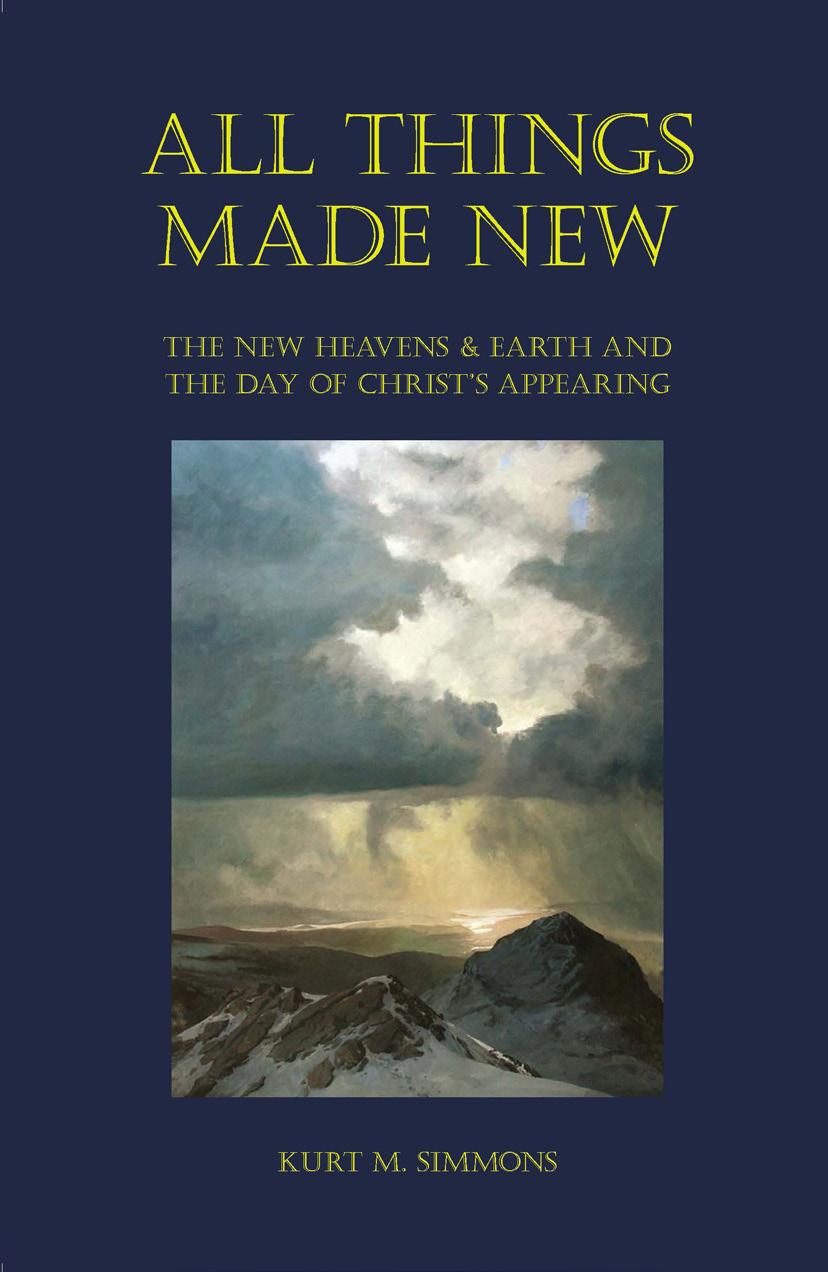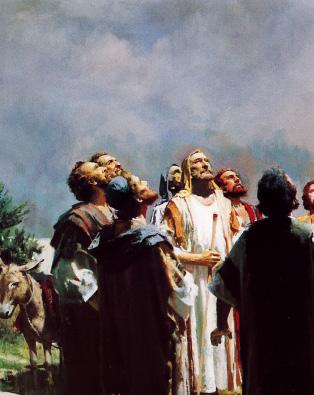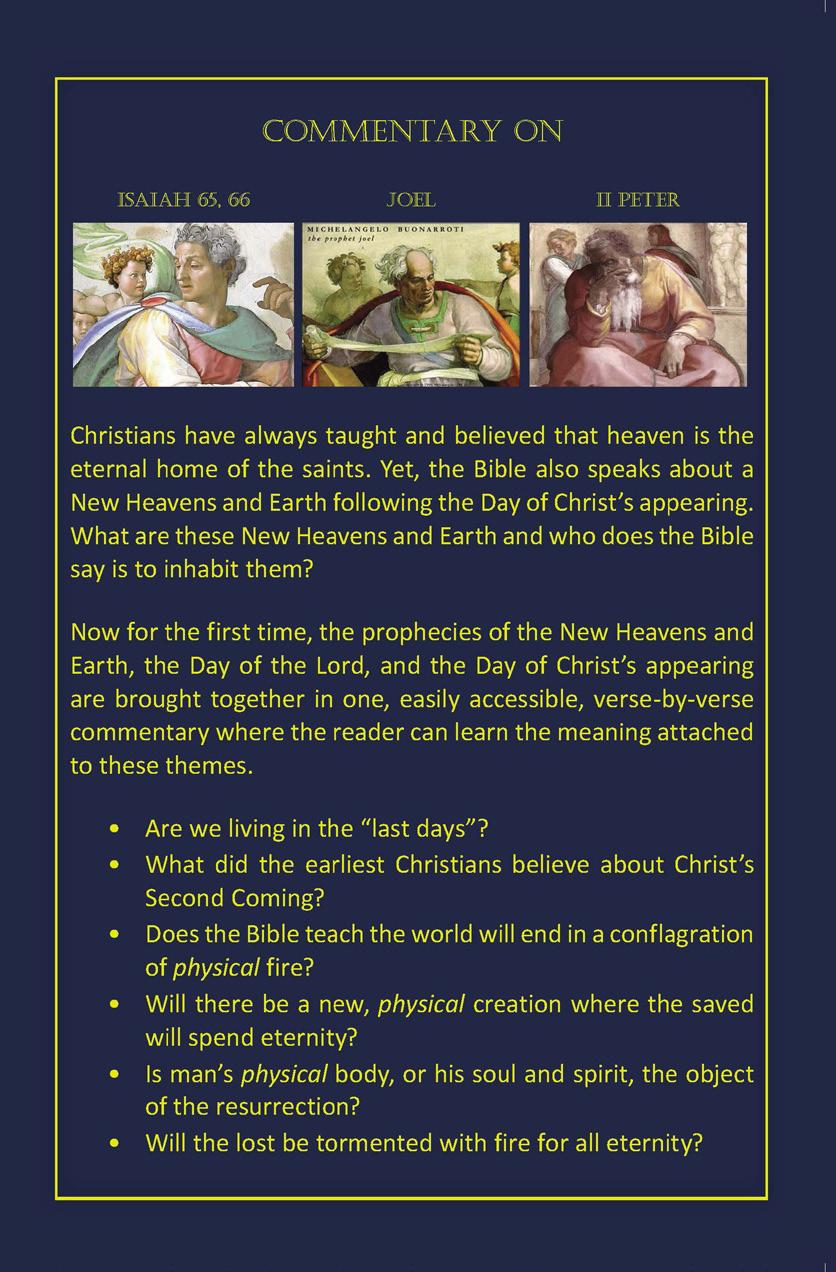
7 minute read
Perspectives Gehenna - Kurt Simmons
Perspectives
Gehenna
Advertisement
by Kurt Simmons

Iappreciated Sam Dawson’s article on Gehenna in the fall edition of Fulfilled! magazine. I agree that the Bible does not teach Eternal Conscious Torment (ECT) of the lost. Sam attributes the notion of ECT to the Catholic Church, but it actually originates with the Greeks and Romans.
The Greeks and Romans believed in the immortality of the soul, which lived forever in an endless cycle of birth, death, and rebirth (reincarnation). They taught that there were four places in Hades inhabited by the dead: “Limbo,” “Purgatory,” “Elysium,” and “Tartarus.” Most men would pass through Limbo, Purgatory, and Elysium to be born again to earthly life. However, the wicked were tormented eternally in Tartarus (Virgil, Aeneid VI, 540-627). This basic belief structure, including Limbo, Purgatory, and Hell (Tartarus), found its way into the Catholic Church, where it has existed ever since. The Reformers jettisoned most of these errors as having no colorable basis in Scripture, but clung to the notion of Hell and ETC, which continue to exist in much of the Protestant Church.
Although I agree with Sam that God does not torture the lost eternally in Hell, I do not agree with his analysis that Gehenna refers exclusively or even necessarily to the literal valley of Hinnom outside of Jerusalem. Instead, I believe a candid study will show that New Testament references to Gehenna are impressed with a symbolic dimension pointing to the place where the lost suffer final punishment and extinction or annihilation.
Prior to the general Hadean resurrection, the dead went to one of two places: Hades Paradise (also called “Abraham’s bosom,” or the “third heaven”; cf. Luke 16:22; 23:43; Acts 2:27; 2 Cor 12:2-4) or Hades Tartarus, called the “Pit” in the Old Testament (Ezek. 27:20; Luke 16:23; 2 Peter 2:4). At the Hadean resurrection in AD 70, the souls in Hades went either to Heaven or the lake of fire (also called the “second death,” Rev 20:14). Everyone who does not inherit eternal life suffers extinction in the lake of fire or second death (Rev 20:15).
Since all who fail to obtain eternal life suffer the second death, first-century Jews who rejected Jesus and the gospel would also have suffered this fate. Therefore, when Jesus asks the Pharisees “how shall you escape the damnation of hell?” (Gk. “judgment of Gehenna” – Matt 23:33 – a passage Sam does not discuss), it seems rather obvious that He is not talking about the physical valley of Hinnom outside Jerusalem. The Pharisees could very easily have escaped death or burial in the valley of Hinnom by moving to Rome or some other ancient city, or even by simply dying prior to the Jewish war with Rome (AD 66-70) when the bodies of those who perished from famine in the siege were cast into that abyss.
When Jesus asked “how shall you escape damnation of Gehenna,” it is clear He alludes instead to the inevitable destruction in the lake of fire that awaits all who fail to attain salvation in Christ. The fact that Jesus calls this destruction inescapable proves that this is so, and that the literal valley of Hinnom is not in view.
To the above must be added Matthew 10:28. There, Jesus warns the righteous that they can suffer the fate of the wicked if they deny Him amidst their persecutions: “Fear not them which kill the body, but are not able to kill the soul: but rather fear him which is able to destroy both soul and body in hell” (Gehenna; cf. Mark 8:34-38).
The dichotomy here is between death of the physical body and death of the soul. Men may kill the body, but only God can kill the soul. The usage here must therefore be distinguished from Joshua 10:39, cited by Sam, where “destroying the souls” of the Canaanites signifies taking away life, but says nothing about the soul or spirit of the dead. If physical death is the “first death,” then death of the soul is the “second death.” Physical death can occur in a physical location, but the soul, being a spiritual thing, cannot suffer extinction in a physical place. Therefore, when Jesus warns that denying Him may result in the destruction of the soul in Gehenna, He cannot have in view the physical valley of Hinnom outside Jerusalem. Rather, He has in view the lake of fire, which is the second death (Rev 20:14, 15).
Hence, in both of these cases (Matt 10:28 and Matt 23:33), Gehenna is seen to be a Read the latest from the pen of Kurt Simmons
Kurt Simmons is the president of the Bi-Millennial Preterist Association. He may be reached at: www.preteristcentral.com k.simmons@windstream.net 1628 N. Guadalupe Street Carslbad, NM 88220 (575) 236-6111
from Joshua 10:39, cited by Sam, where “destroying the souls” of the Canaanites signifies taking away physical life, but says nothing about the soul or spirit of the dead. If physical death is the “first death,” then death of the soul is the “second death.” Physical death can occur in a physical location, but the soul, being a spiritual thing, cannot suffer extinction in a physical place. Therefore, when Jesus warns that denying Him may result in the destruction of the soul in Gehenna, He cannot have in view the physical valley of Hinnom outside Jerusalem. Rather, He has in view the lake of fire, which is the second death (Rev 20:14, 15).
Hence, in both of these cases (Matt 10:28 and Matt 23:33), Gehenna is seen to be a symbol for the lake of fire and not a reference to the literal valley beyond J e r u s a l e m ’ s walls.
The above conclusion is s t r e n g t h e n e d by Matthew 25:31-46, where the dead of all nations— including firstcentury Jews— stand before the judgment seat of Christ and the lost are sent into “everlasting fire prepared for the devil and his angels” (v. 41). In Revelation 19:20 and 20:10, we learn that the devil and his minions are cast into the lake of fire. Hence, the everlasting fire of Read the latest from the pen of Kurt Simmons

Matthew 25:41 is the same as the lake of fire of Revelation 19:20 and 20:10, 14, 15. But as we have already established that the lake of fire is another name for Gehenna, it follows that the everlasting fire of Matthew 25:41 also refers to Gehenna (if A = B and B = C, then A = C). Since “all nations” were liable to the lake of fire, and since “all nations” includes first-century Jews, it was to the lake of fire Jesus referred when He warned His countrymen of the danger of Gehenna, not physical death in the valley of Hinnom.
This is confirmed by the Greek. The phrase “everlasting fire” in Matthew 25:41 is πυρ το αιονιον. The identical phrase occurs in Matthew 18:8, where Jesus states that it is better to enter life halt or maimed than with two hands or two feet to be cast into “everlasting fire” (πυρ το αιονιον). However, the parallel passage in Mark alters the wording slightly and adds the word Gehenna: And if thy hand offend thee, cut if off: it is better for thee to enter halt into life, than having two hands to go into hell (γεενναν), into the fire that never shall be quenched (πυρ το ασβεστον). Mark. 9:43 If the unquenchable fire of Gehenna in Mark 9:43 = the everlasting fire in Matthew 18:8 and 25:41; and if the everlasting fire of Matthew 25:41 = the lake of fire of Revelation 19:20 and 20:10, 14, 15; then the unquenchable fire of Gehenna in Mark 9:43 = the lake of fire of Revelation 19:20 and 20:10, 14, 15 (if A = B and C, and if C = D, then A = D).
Thus, in each case, we find that the physical valley of Hinnom is nowhere in view and that Gehenna invariably refers to the lake of fire, or second death.
Conclusion: Gehenna was a literal valley of Hinnom outside Jerusalem, but had symbolic import and meaning which pointed to the place where the souls of the lost suffered final extinction in the lake of fire, the second death. It is artificial to read New Testament warnings about destruction in Gehenna in an overly literal manner, as referring to the Jewish war with Rome and having one’s body cast into the physical valley, just as it is artificial to read Eternal Conscious Torment into the imagery of the second death. The better view is the middle way set out above. V






